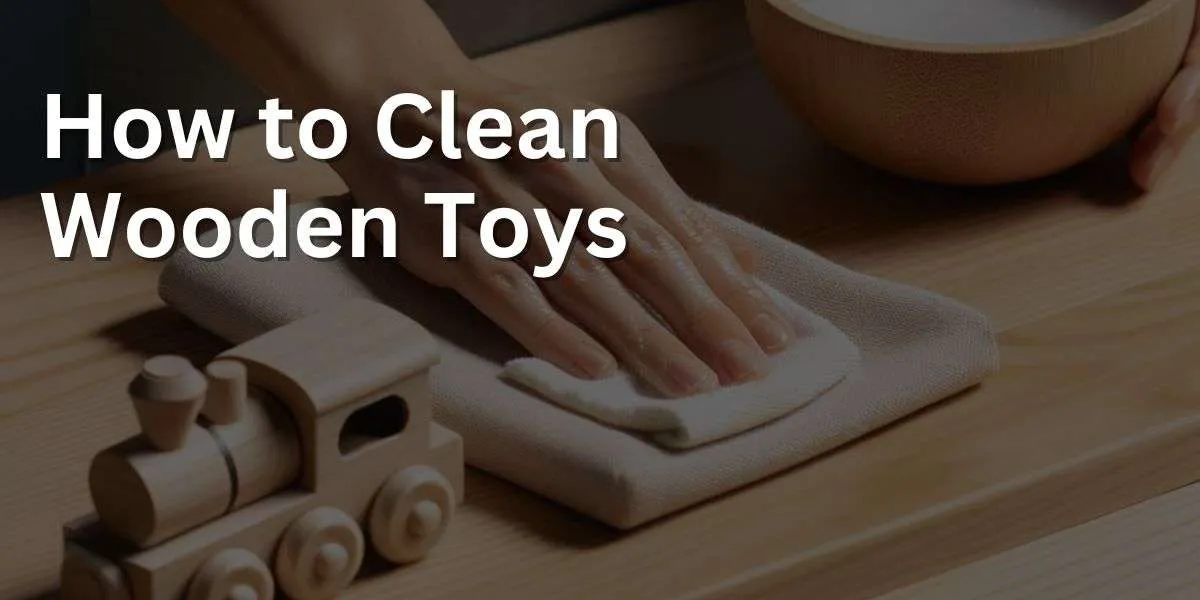Discover the art of maintaining the natural charm of wooden toys with our guide on How to Clean Wooden Toys effectively and safely.
In this article, we delve into the best practices for preserving the integrity of wood, the use of non-toxic cleaning agents, and the techniques that prevent damage while ensuring your child’s playthings remain hygienic and durable.
From beeswax polishes to gentle soap solutions, learn how to care for these classic toys so they can be cherished for generations.
Key Takeaways For How to Clean Wooden Toys
- Gentle Cleaning: Use a soft cloth dampened with a mild soap and water solution to wipe the surface without saturating the wood.
- Regular Dusting: Implement a routine of dusting wooden toys with a soft, dry cloth to maintain their luster and prevent grime buildup.
- Avoid Harsh Chemicals: Steer clear of abrasive cleaners and bleach, which can strip the wood’s natural oils and damage the surface.
- Dry Thoroughly: After cleaning, ensure toys are completely air-dried to prevent moisture retention, which can lead to warping or mold.
- Natural Polishes: Occasionally treat wooden toys with natural waxes or oils, like beeswax or coconut oil, to preserve their finish and longevity.
How to clean wooden toys
- Avoid Water Immersion: Never soak or immerse wooden toys in water as this can cause the wood to swell, change shape, and lose color.
- Basic Cleaning: Use a cloth dampened with warm water to wipe the wooden toys. Follow up by air drying them or wiping them down with a dry cloth.
- Cleaning Painted or Varnished Toys: For toys with paint or varnish, you can use a mild soap. Apply the soap with a sponge and rinse well.
- Disinfecting: To disinfect wooden toys, use a solution of white vinegar or apple cider vinegar diluted with water. After applying the solution, air dry the toys or wipe them thoroughly with a cloth.
- Moisturizing the Wood: Depending on the wood type, you may use olive oil to moisturize the wooden toys.
- Avoid Harsh Chemicals: Never use cleaning products intended for wooden furniture or disinfectant wipes, as they can be toxic for children. Instead, use 100% ecological vinegar diluted in water for a safe cleaning solution.
Cleaning wooden toys is a straightforward process that ensures the longevity and safety of these cherished playthings. Begin by wiping the toy with a cloth dampened with mild soapy water to remove dirt and grime. It’s important when you wash wooden toys that the cloth is well-wrung to prevent excess moisture, which can damage the wood.
After the initial wipe-down, a dry cloth should be used to thoroughly dry the children’s toys, maintaining the integrity of the wood and preventing warping or swelling. For a deeper clean, especially for toys that have been mouthed by children, a vinegar and water solution can serve as a natural disinfectant. Applying this solution with a cloth helps to sanitize the toy without introducing harsh chemicals.
Periodically, a child’s wooden toys benefit from conditioning to keep the wood supple – you should oil wooden toys. A natural beeswax or mineral oil can be applied sparingly to nourish the wood and restore its luster. This not only preserves the toy’s appearance but also extends its usable life, making it ready for years of play and exploration.
Cleaning wood toys is a simple and rewarding task, ensuring that these natural, durable play items remain safe and inviting for children to enjoy, even if a little harder than cleaning plastic toys.
How to Disinfect Wooden Toys
Disinfecting wooden toys is key to maintaining a hygienic play environment for children. Begin by wiping the toys with a cloth dipped in a solution of vinegar and water, a natural disinfectant, which eliminates germs without the use of harsh chemicals. It’s essential to wring out the cloth thoroughly to prevent the wood from soaking up too much liquid, which could compromise its durability.
Allowing the toys to air-dry completely after the initial cleaning is crucial to prevent moisture retention. For an extra level of cleanliness, especially after illness or when toys are shared, exposing the wooden items to sunlight for a short period can further aid in the disinfection process, as UV rays have natural sanitizing properties.
When the toys are dry, applying a small amount of food-grade mineral oil or a beeswax blend helps to condition the wood, which protects it from drying out and cracking. This conditioning step acts as a barrier against bacteria and keeps the toys in pristine condition.
Regular disinfection and proper care ensure that wooden toys remain a safe and beloved staple in a child’s daily adventures, fostering play and development while upholding the highest standards of cleanliness and care.
| Steps/Methods | Instructions |
|---|---|
| 1. Gather Supplies | – White vinegar – Lemon juice (optional for added scent and mild disinfecting properties) – Clean cloths or sponges – Spray bottle (optional) – Clean water |
| 2. Prepare the Solution | – Mix equal parts of white vinegar and water in a bowl or spray bottle. Vinegar acts as a natural disinfectant. – You can add a few drops of lemon juice for a pleasant scent and a mild boost in disinfecting power. |
| 3. Wipe Down | – If using a bowl: Dip a clean cloth into the solution, wring out excess liquid, and wipe down the entire surface of the toy. – If using a spray bottle: Lightly spray the solution onto the toy and wipe down with a clean cloth. |
| 4. Avoid Soaking | – Be cautious not to oversaturate the wood. The cloth or sponge should be damp, not dripping wet. – Avoid submerging wooden toys in any liquid, as this can cause swelling, warping, or other damage. |
| 5. Allow to Air Dry | – After wiping down with the disinfecting solution, allow the toys to air dry completely. – Ensure toys are dried in a well-ventilated area. |
| 6. Rinse (if necessary) | – If you’re concerned about the vinegar smell or residue, you can wipe down the toys with a cloth dampened with clean water. – Again, ensure the toys are dried thoroughly after this step. |
| 7. Regular Maintenance | – For daily or regular cleaning, a simple wipe down with water and a mild soap can suffice. – Disinfecting can be done weekly or after any potential exposure to germs. |
Note: While vinegar is an effective natural disinfectant, it may not eliminate all types of germs or viruses. If you’re looking for a stronger disinfecting solution, it’s essential to choose one safe for children and wood surfaces. Always read labels and do a patch test before applying any new solution to the entire toy.
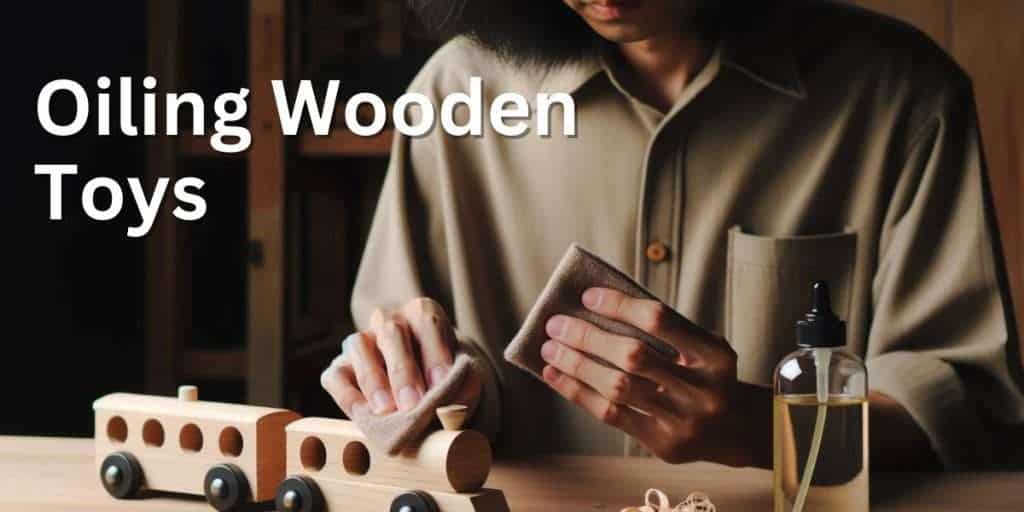
Oiling wooden toys
Oiling wooden toys preserves their natural beauty and enhances their longevity. Opting for a natural, food-grade oil such as coconut or flaxseed oil protects the wood and is safe for children who may put toys in their mouths. Begin by ensuring the toy is clean and completely dry, which allows the oil to penetrate effectively.
Applying oil with a soft cloth in a thin, even layer brings out the wood’s warm glow and highlights its unique grain. It’s beneficial to let the oil soak into the wood for a few hours or, ideally, overnight, which provides ample time for absorption.
After the soaking period, buffing the wood with a clean cloth removes any excess oil, ensuring the toy is not slippery and leaves a smooth, matte finish. This not only beautifies the toy but also creates a subtle protective layer that repels moisture and dirt.
Regular oiling, perhaps every few months or when the wood looks dry, keeps wooden toys inviting and ready for years of imaginative play. It’s a simple, yet rewarding process that turns maintenance into an act of care for cherished playthings.
Don’t think of a toy as broken if the paint or varnish starts to chip. Because they are made of wood you can simply sand down the area and repaint. You could even change the colour entirely if you wanted to. This is just one of the many reasons why wooden toys are better than plastic.
If your toys have got really grubby a more concentrated vinegar solution can be used to help get out stains. And really stubborn stains can be sanded down and repainted.
You can get water-based child-safe stains fairly easily so it’s just a case of finding the perfect colour although we definitely think a few marks and stains give toys character.
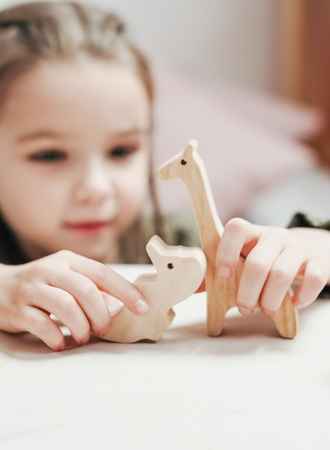
How to store wooden toys
Storing wooden toys properly maintains their quality and ensures they are ready for future play. To start, designate a dry, cool place away from direct sunlight to prevent warping and fading. Wooden toys prefer the stability of consistent temperatures and avoid the damage that humidity and heat can cause.
Using open shelving or bins allows for easy access and encourages organization among children. It’s beneficial to place heavier items on the bottom and lighter ones on top to prevent toppling and reduce wear. For toys with moving parts or delicate designs, individual cloth bags or fabric-lined boxes can provide protection against scratches and keep components together.
Regularly rotating toys keeps the collection fresh and reduces clutter . This system not only simplifies storage but also rekindles interest in toys that have been out of sight. Lastly, involving children in the storage process teaches responsibility and care for their belongings, turning the act of storing into an extension of playtime itself.
Proper storage extends the life of wooden toys, making them a lasting fixture in the playroom and preserving their charm for generations.
| Storage Aspect | Recommendations | Reasoning/Details |
|---|---|---|
| Cleanliness | Clean toys before storage | Remove any dirt, grime, or residues. Use a damp cloth to wipe them down and ensure they are completely dry before storing to prevent mold or mildew. |
| Dry Environment | Store in a dry place | Humidity or moisture can cause wooden toys to swell, warp, or develop mold. Always ensure they are stored in a dry environment. |
| Temperature | Avoid extreme temperatures | Extreme cold or heat can cause wood to crack or warp. Store wooden toys in a room with a consistent, moderate temperature. |
| Storage Containers | Use breathable containers | While plastic bins are convenient, they can trap moisture. If using them, ensure they are not airtight. Cloth bins or wooden crates can be good alternatives. |
| Organizing | Store by size/type | Store larger toys at the bottom and smaller ones at the top. Consider using dividers or compartments for smaller items. |
| Sunlight | Avoid direct sunlight | Prolonged exposure to sunlight can fade the paint or finish on wooden toys. Store them away from direct sunlight or in a shaded area. |
| Accessibility | Keep frequently used toys within reach | For toys that are used often, store them in an easily accessible location, so they are easy to take out and put away. |
| Safety | Secure storage units | If using shelves or cabinets, ensure they are anchored to the wall to prevent them from tipping over, especially if children access them regularly. |
| Regular Checks | Periodically inspect for damage | Over time, wooden toys might develop splinters or the paint might chip. Regularly inspect and repair or discard damaged toys. |
Additional Tips:
- If you’re storing wooden toys for an extended period, consider placing silica gel packs in the storage container to absorb excess moisture.
- Regularly air out storage spaces to prevent the buildup of moisture or stale air.
- Rotate toys periodically to ensure even usage and to rediscover forgotten toys.
By following these storage guidelines, you can ensure that wooden toys remain in good condition and are safe for children to play with for years to come.
Toys undoubtedly take up a lot of space, and so it can be tempting and even necessary to get rid of things fairly quickly once children grow out of them. However, there are certainly some heirloom-worthy toys that are worth passing down to future generations. If of course, you have the space to store them.
If you are lucky enough to be living in your forever home, or have a family home with storage space you can access then it’s certainly tempting to keep your favourite toys to pass on. And it’s certainly far better than throwing them away.
Open ended toys that require maximum involvement an imagination are certainly the best ones to keep as they are timeless. Think wooden animals, building blocks, simple toy cars and train sets. These toys have changed very little over hundreds if not thousands of years and are very unlikely to go out of favour.
FAQs on best way to clean wooden toys
Do wooden toys need to be sanitized?
It is generally not necessary to sanitize wooden toys, as wood is naturally antibacterial and less likely to harbor germs than plastic or other materials.
However, if your child’s wooden toys have come into contact with any bodily fluids or other potentially hazardous substances, it may be a good idea to disinfect them to prevent the spread of germs.
To disinfect wooden toys, you can use a solution of warm water and mild soap or white vinegar. Simply lightly dampen a cloth with the cleaning solution and gently wipe the toy down.
This will remove any dirt and grime, and the mild soap or vinegar will help to disinfect the toy. Allow the toy to air dry, or if it is small enough, you can dry it off with a clean cloth.
Keep in mind that it is not recommended to soak wooden toys, as they may become misshapen. Additionally, avoid using harsh chemicals or bleach to clean wooden toys, as these may damage the wood or cause fading or discoloration.
Simply cleaning and disinfecting the toy with a mild solution should be sufficient to keep it safe and hygienic for your child to play with for many years of creative play.
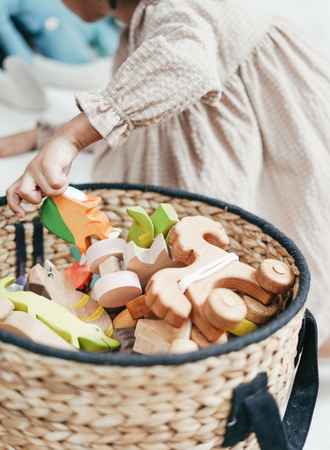
How do you clean kids building blocks?
To clean kids’ wooden building blocks, you can follow these steps:
- Gather all of the blocks and sort them by type or color.
- Dust off any loose dirt or debris with a soft cloth or a dust brush.
- Mix a solution of warm water and mild soap or white vinegar in a bucket or sink.
- Lightly dampen a cloth with the cleaning solution and gently wipe down the blocks. Be sure to get into any crevices or grooves to remove any dirt or grime.
- Rinse the blocks thoroughly with clean water to remove any soap residue.
- Allow the blocks to air dry or pat them dry with a clean cloth.
Avoid soaking wooden blocks, as they may become misshapen.
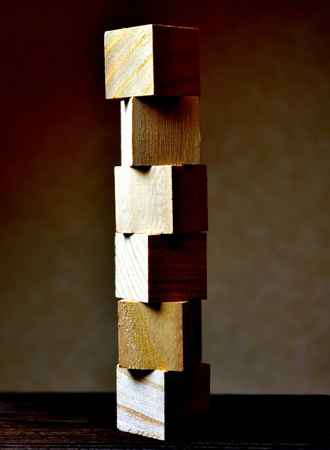
How do you oil wooden blocks?
Trust me, it’s super simple and it’ll help to preserve the wood and keep it looking its best. After you have cleaned your blocks in a soap solution (see above) then for proper care, its time to oil them to keep them in the best condition.
- Mineral oil or beeswax work great for wooden toys. Just make sure to steer clear of any oils that contain synthetic fragrances or additives – they’re not safe for little ones.
- Place a small amount of oil on a clean cloth or soft brush.
- Gently rub the oil into the blocks, making sure to cover all surfaces.
- Let the oil soak in for a few hours or overnight.
- Wipe off any excess oil with a clean, dry cloth.

